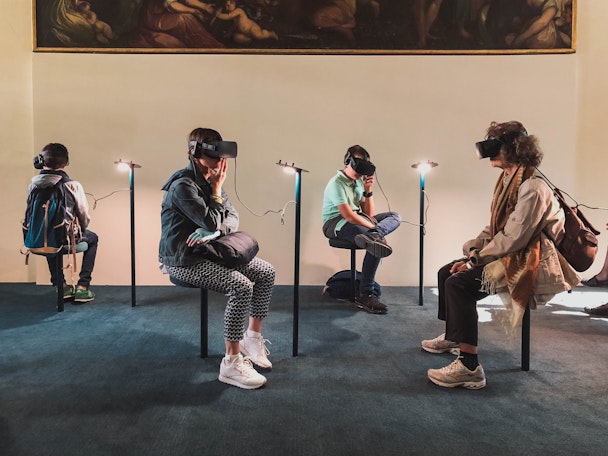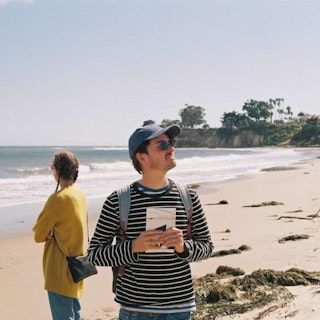What does the future hold for AR, VR and experiential marketing?
At a recent roundtable event with marketing leaders in the augmented reality (AR) and virtual reality (VR) spaces, we asked them what they’re hoping for next in this fast-moving space.

AR and VR aren’t sitting still. So where are they heading? / Lucrezia Carnelos via Unsplash
Rosie Copland-Mann, senior creative strategist, Amplify
I’m excited about moving away from first-market PR stunts that no one is interested in or wants to use, towards real-world use cases that provide incredible entertainment or serious utility. I hope that might defeat some of the skepticism around these technologies. They’re starting to be talked about in an exciting way because they are really exciting. How can you use AR to understand your surroundings in a better way? How can you use AR to enhance the physical world with something more playful? These interesting ways of using technology, instead of PR gimmicks: that’s what I’m excited about.
Advertisement
Bradley Stacey, technology strategist, Bray Leino
I hope we’ll be able to knock down some quite substantial barriers. For example, by virtualizing events, we could invite entire companies or groups of people rather than only high-flying individuals (and not having to get people on a plane or put them in a hotel). It’s the idea of being able to include the next billion, including people from completely different social, ethnic and cultural backgrounds. A level playing field really appeals to me.
There’s a big asterisk though: if we find ourselves having to ‘skin’ our voices or change our appearance or behavior to display (what we perceive to be) more acceptable forms of ourselves, that could create an uncomfortable form of homogeny. That can be dangerous. I urge everybody to be themselves and to really engage with the tech in a way that works for them.
Advertisement
Amy Blackman, thought partner, Spiro
A lot of what’s exciting to me lies at the intersection of technology, inclusion, and representation. We’ve seen it go horribly wrong with facial recognition and racial profiling. But how can we work to get it right? For disability inclusion, the physical experience of attending experiences may not be accessible for all right now. But the whole point of technology is to be a focal point for more human experience. It can be.
Austin Bennett, director, creative technology, integrated production, Momentum Worldwide
With technologies like AR and VR, we can make truly unique, mind-blowing experiences and we can reach so many people with them. If we look to the future, I’m becoming obsessed with these big, super cool capture volumes [ways of recording objects and events, making them appear to take up 3D space]. Bringing people into these environments is great; it’d be very cool to also bring those virtual experiences to people in real life. I’d love to see miniature experiences where people can jump in and see what these virtual worlds are like without having to use a specialized device.
Suggested newsletters for you
Mark Mitchell, founding partner, Lively Agency
There are so many technological advances in the field (inputs, mobile browsers, AR experiences). 5G is a super interesting one. The power of being genuinely low-latency is huge. The classic example is the surgeon operating a scalpel remotely with a VR headset; incredible things are possible.
It’s early to talk about this, but when you kind of look at things like [brain-machine interface tech] Neuralink, you see the ways that these technologies are extending reality, making it bigger and bolder. The possibilities are incredible.
Zara Kerwood, creative technology director, George P. Johnson UK
From a creative technology perspective, these technologies are a springboard to creativity. All great experiences have an idea at the heart of them. We use these tools to unlock experiences. Those experiences can be richer, deeper, and better shared with groups of people. That’s what will lead to value in the experiential space.
Right now, I see opportunities across remote audiences, entertainment and richer and deeper storytelling. Storytelling has huge potential in this space. The tools that are coming to the fore will allow us to create brand stories in ways that we haven’t been able to. What I would say to brands is: keep curious; be open. When these technologies come about, we don’t always know what they’re going to be used for in the future. So let’s keep looking at them.
Content created with:

Amplify
We solve problems.
At the heart of any problem is a person. A real person. What they think, believe, want or need. We help brands to connect with them and...

Bray Leino
We drive growth through creativenergy®, by going beyond, to find the most powerful way. It’s the way we began back in 1973. Before email, before mobile phones,...
Find out more
Spiro
This is Spiro. A strategically-led, creatively-driven, industry-leading global brand experience agency.
We exist to cultivate purposeful connection. We specialize...

Momentum Worldwide
Momentum Worldwide is a global experience agency partnering with and transforming the world’s most famous brands since 1987. Built on the simple truth that it’s...
Find out more
LIVELY WORLDWIDE LLC
We create without constraints.
Our work sits at the intersection of creativity and technology.
With one eye on the data and another on the future,...

George P. Johnson
George P. Johnson is the world’s leading experiential marketing agency. We power brand experiences by enabling marketers to benefit from integrated experiential...
Find out more
